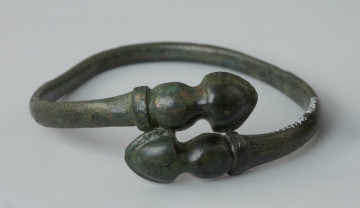
Tortoiseshell buckle
National Museum in Szczecin
Part of the collection: Antiquity
The bracelet from Borzytuchom is an example representing the so-called snake-head types, described this way due to a characteristic shape of its ends. This accessory was a typical element of the clothing among German people from Wielbark culture in the 1st-2nd centuries. The people representing this culture are associated with the Goths and Gepids tribes. The Wielbark communities occupied the Pomerania in the period from the 1st century until the mid-5th century. They were famous for highly developed non-ferrous metal metallurgy, including advanced goldsmithing. The people from Wielbark culture used to bury their dead both in the inhumation burials and cremation burials. It is worth noting that the burial rituals of the Wielbark culture are distinguished by a complete lack of armor and iron objects in the grave goods. The bracelets are usually found in the female graves, together with fibulae (brooches used to fasten clothing), strap fittings and other accessories used to decorate the garments and body. The Borzytuchom bracelet was made from bronze, in accordance with the Wielbark culture’s tradition, although such objects were also made from other types of precious metals, mainly silver. This object comes from the assemblage of an urned cremation that was discovered by accident in 1879. A tall cup with a band-like handle, bulged at the lower part of the body, was used as an urn. Just as the snake-head bracelet, this type of pottery is typical for the Wielbark culture.
Bartłomiej Rogalski
Author / creator
Dimensions
cały obiekt: width: 1.7 cm, diameter: 8.3 cm
Object type
jewellery; snake bracelet
Technique
casting
Material
bronze
Creation / finding place
Owner
Muzeum Narodowe w Szczecinie
Identification number
Location / status

National Museum in Szczecin

National Museum in Szczecin

National Museum in Szczecin
DISCOVER this TOPIC
National Museum in Lublin
DISCOVER this PATH
Educational path